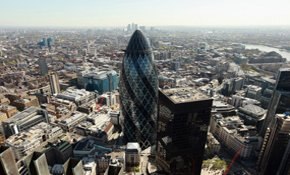It has taken six long years but the shrunken British economy has now, finally, grown back to the size it was before the banking system came close to collapse and plunged the world into recession. What’s more, Britain is now surging ahead more vigorously than any other advanced economy. But can it last? Is the recovery still too dependent on us, the consumers? And are we still too ready to get into debt to pay for our habit? And what will happen when interest rates finally start to rise?
The Office for National Statistics has published figures that in themselves seemed not especially significant. We learned that in the second quarter of this year the British economy grew by 0.8%. Quarterly figures of economic growth have become quite familiar recently but what made these figures special was that this latest burst of growth had pushed the economy back to the size it was in early 2008 when the financial crisis started to wreak havoc on the world economy. In fact the economy is now 0.2% bigger. George Osborne, the Chancellor, said it marked “a major milestone”.
Since 2008 we have experienced not the deepest but the longest recession of modern times and Britain has taken longer than most other countries to get back to where we were. Germany and the United States, for example, restored their economies to their previous strengths quite some time ago. Why Britain should have been so much slower at doing so is a matter of intense academic and, of course, political controversy. Some attribute the slowness of our recovery to Britain’s dependency on its financial services industry which, inevitably, was hit especially badly by the banking crisis. Others blame the government’s so-called ‘austerity’ policies for unnecessarily prolonging the recession.
What’s clear now, though, is that the British economy is surging ahead faster than the others. When the International Monetary Fund published the summer update of its World Economic Outlook it revised downwards its forecast of global economic growth but, for the fifth successive quarter, upgraded its forecast for British economic growth. It expects the British economy to grow by 3.2% this year and 2.7% next.
Not all the figures are so rosy, however. The ONS points out that although the British economy in total is now back to the size it was in early 2008, output per head won’t get back to the level of those days until 2017. What’s more, it is the service sector that has been largely responsible for restoring the overall size of the economy; manufacturing and construction have not yet regained their former strength.
Nor has the economy yet been ‘rebalanced’ in the way that Mr Osborne, has always said was vital if the economic recovery were to be sustainable. What he meant was that the economy was too dependent on the spending of both consumers and the government (both, in part, financed by debt) to sustain the recovery and that investment and exports needed to grow more strongly if the economy were to be properly balanced. It’s true that business investment has been picking up recently but exports continue to be disappointing, not least because of enduring sluggishness in the eurozone, our biggest export market.
There are other clouds too in the otherwise sunny economic sky. The recent burst of growth was supposed to have done wonders for the government’s own finances, as greater economic activity generated higher tax revenues, so helping to reduce the government’s deficit. But this isn’t happening, or at least not yet. Even though we have had four successive quarters of economic growth, public finances have hardly got any better. In June this year the government had to borrow £11.4bn to pay its bills, only £100m less than it had to borrow in the same month the previous year. Its borrowing in the most recent quarter is actually 7.3% higher than in the previous year. There may be special factors involved here, and the government finances may improve markedly towards the end of the financial year, but these recent figures are hardly cheering for Mr Osborne.
But the biggest cloud on the horizon comes in the form of interest rates. The official interest rate, set by the Bank of England and which acts as the marker for all other rates, has been at the historically low rate of 0.5% since 2009. The normal rate is more like 5.0%. Everyone agrees that rates need to rise, simply in order to encourage people to save and to stop the already huge burden of personal debt from getting even bigger. The Governor of the Bank, Mark Carney, said himself this week that rates “will need to start to rise”. He told me in an interview some weeks ago that the “new normal” rate should be in the region of 2.3% - 2.5%.
But many people have got so used to low interest rates that it’s feared they’ll be in for a very unpleasant shock when rates do indeed go up. The principle worry here is the housing market whose buoyancy has restored prices to and beyond the levels seen before the crash. In some areas, notably in London, thousands of people have had to take out huge mortgages just to get on to the property ladder. They may just about be able to find the money for the monthly payments on those mortgages with interest rates as low as they are now, but once those rates start to rise, many could find themselves in real financial difficulties.
This week the Resolution Foundation, a think tank, produced some alarming figures. It reckons that even if rates rise only to 2.9% by 2018, the number of households struggling with mortgage payments will double to 2.3 million and 1.1 million of these would find themselves in a position that is called ‘debt peril’. That means more than half of a household’s post-tax income being taken up simply with paying the mortgage. It estimates that by 2018 UK household debt will have risen from £1.6 trillion today to £2.2 trillion: all of this will have to be serviced at increasing cost as interest rates rise to their historic norm.
Such an outlook is terrible for the individuals faced with rising mortgage and other debt interest bills, especially if their incomes go on failing to rise at the same rate. Matthew Whittaker of the Resolution Foundation said: “Borrowers on low and middle incomes face the perfect storm of rising interest rates and stagnant incomes.”
But this prospect is also very bad for the economy at large. That’s because households, squeezed by the need to pay more on debt interest, will be forced to rein in their spending elsewhere and that shrinking of consumer demand will threaten to put an end to the economic boom.
Unsurprisingly, then, the Bank of England’s Monetary Policy Committee, which sets interest rates, is expected to be extremely cautious in its first moves to raise rates. Some commentators think the initial rise could be as little as one eighth of one per cent. But even if the rate rises are extremely gradual, interest rates will still eventually have to reach a level that will impose real financial hardship on many households.
So it is perhaps best to enjoy the current good economic news while we can for, like the equally glorious summer, it is not likely to last.
How cheered do you feel by the news that the British economy is back to the size it was in 2008? What do you think the economic future holds? And are you spending or saving?










